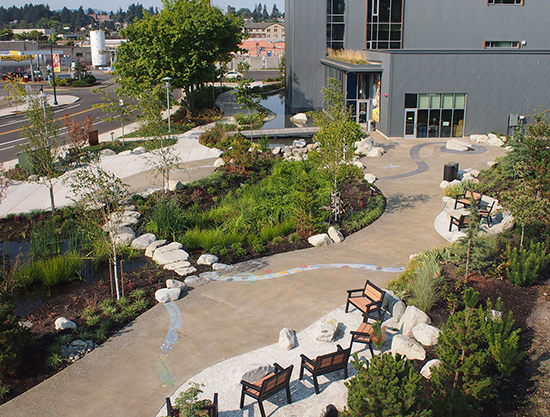|
Subscribe / Renew |
|
|
Contact Us |
|
| ► Subscribe to our Free Weekly Newsletter | |
| home | Welcome, sign in or click here to subscribe. | login |
Construction
| |
 |
May 17, 2013
Special applications: Artistic merit / tie
East Bay Public Plaza
Location: Olympia
Owner/developer: LOTT Alliance
Project team: Berschauer Phillips Construction Co., general contractor; Robert W. Droll Landscape, landscape architect; Belarde Co., concrete contractor; Miles Sand & Gravel Co., ready-mix supplier
East Bay Public Plaza was designed to acknowledge how reclaimed water moves through our environment.
This waterfront plaza has an interactive stream that uses reclaimed water and pavement designs that replicate Pacific Northwest shorelines.
Three prominent concrete hardscape features contribute to the success of the project: the sedimentary cutbank wall and stream, the mosaic waterlines, and the waved-gradation concrete paving.
The concrete contractor worked closely with the landscape architect to achieve the look of an actual Pacific Northwest cutbank wall. The wall includes seeps that enable a slow water trickle, stained concrete drips to show a variety of colors and shades, strategically placed rocks, and artesian springs in the streambed.
Each mosaic waterline includes a bronze water-themed educational phrase surrounded by thousands of hand-selected, hand-cut and hand-placed glass tiles assembled by an artist. The artwork itself was then installed by the concrete contractor.
Although there were several challenges, major precautions were taken on the shotcrete installation of the cutbank wall and the mosaics. Three different integral colors were layered in the cutbank wall, which required switching concrete trucks during each layered pour. Another challenge included making sure the seeps were aligned properly with the plumbing to allow for proper water flow.
The massive size and weight of the tiled mosaic artwork sheets — some over 20 feet long — required a deliberate and deft touch. Additionally, the artwork had be adjusted so that it did not fall directly into a control joint. This was avoided by slightly shifting the entire art piece or making minor adjustments to the artwork itself.
Ready-mix concrete was used to create this outdoor artistic space for a number of reasons, including durability, project aesthetics, job-site cleanliness, waste management and sustainability.
Other Stories:
- Shotcrete helps restore a school that went up in flames
- Concrete paving
Martin Luther King Jr. Way phase one - Special applications: Technical merit
Columbia ColStor - Special applications: Artistic merit / tie
Everett Performing Arts Plaza - Pervious concrete
Woods at Golden Given - Architectural/decorative concrete / tie
Lake Washington High School - Residential structures
Lions Gate - Architectural/decorative concrete / tie
St. Martin’s Abbey courtyard - Residential decorative concrete
Sprague residence - Public works: Bridges
Manette Bridge replacement - Public works: Infrastructure
Maple Leaf Reservoir - Cast-in-place structures
Seattle Cancer Care Alliance Proton Therapy - GRAND AWARD/Tilt-up structures
Everett Clinic Smokey Point Medical Center - Renton Memorial Stadium owes its good looks to concrete
- Public renovations
Percival Landing major rehabilitation



